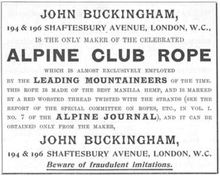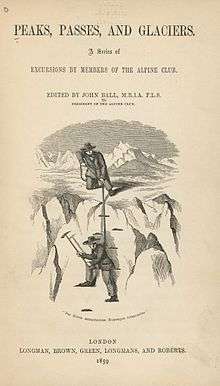Alpine Club (UK)
| Formation | December 22, 1857 |
|---|---|
| Headquarters | 55-56 Charlotte Road, Shoreditch |
| Website |
alpine-club |
The Alpine Club was founded in London in 1857 and is the world's first mountaineering club. It is UK mountaineering's acknowledged 'senior club'.
History

On 22 December 1857 a group of British mountaineers met at Ashley's Hotel in London. All were active in the Alps and instrumental in the development of alpine mountaineering during the golden age of alpinism (1854–1865). It was at this meeting that the Alpine Club, under the chairmanship of E. S. Kennedy, was born. John Ball was the first president and Kennedy, the first vice-president, succeeded him as president of the club from 1860 to 1863. It then moved its headquarters to the Metropole Hotel.
For climbing, a rope was required which would be both strong and light so that lengths of it could be carried easily. A committee of the club tested samples from suppliers and prepared a specification. The official Alpine Club Rope was then made by John Buckingham of Bloomsbury. It was made from three strands of manila hemp, treated to be rot proof and marked with a red thread of worsted yarn.[1]
One hundred and fifty years later, the Alpine Club continues, and its members remain extremely active in the Alps and the Greater Ranges, as well as in mountain arts, literature and science.
For many years it had the characteristics of a London-based Gentlemen's club, including a certain imprecision in the qualification for membership (said to have been 'A reasonable number of respectable peaks'). Until 1974, the club was strictly for men only, but in 1975, within months of membership being opened to women, a merger with the Ladies' Alpine Club was agreed, and the Club thus gained about 150 new members.[2] By the last quarter of the 20th century, the club had evolved into Britain's senior mountaineering club, with a clear qualification for membership, for both men and women, and an 'aspirant' grade for those working towards full membership. However, it still requires prospective members to be proposed and seconded by existing members.
Though the club organises some UK-based meets, its primary focus has always tended towards mountaineering overseas, and it is associated more with exploratory mountaineering than with purely technical climbing (the early club was once dismissed as doing very little climbing but 'a lot of walking steeply uphill'). These higher technical standards were often to be found in offshoots such as the 'Alpine Climbing Group' (ACG), founded in 1952.
The club has produced a suite of guidebooks which cover some of the more popular Alpine mountaineering regions. It also holds extensive book and photo libraries as well as an archive of historical artifacts which are regularly lent out to exhibitions. The club's history has recently been documented by George Band in his book Summit: 150 Years of the Alpine Club, and its artists in The Artists of the Alpine Club by Peter Mallalieu. Its members' activities are recounted annually in the club's publication the Alpine Journal.
As of 2009, the membership subscription costs between £39 and £60 per year, with a £27 rate for younger members. There is no joining fee .
Presidents

- 1857–1860: John Ball
- 1860–1863: E. S. Kennedy
- 1863–1865: Alfred Wills
- 1865–1868: Leslie Stephen
- 1868–1871: Charles Edward Mathews
- 1871–1874: William Longman
- 1875–1877: Thomas Woodbine Hinchliff
- 1881–1883: Thomas George Bonney
- 1884–1886: Florence Crauford Grove
- 1886–1890: Clinton Thomas Dent
- 1890–1893: Horace Walker
- 1893–1896: Douglas Freshfield
- 1896–1899: Charles Pilkington
- 1899–1902: Dr James Bryce (later Viscount Bryce)
- 1902–1904: Sir Martin Conway (later Lord Conway of Allington)
- 1904–1906: George Forrest Browne, Bishop of Bristol
- 1908–1911: Hermann Wooley
- 1911–1914: W. E. Davison
- 1914–1917:
- 1917–1919: John Percy Farrar
- 1920–1923: J. Norman Collie
- 1923–1926: Charles Granville Bruce
- 1926–1929: Sir George Henry Morse
- 1929–1932: Claude Wilson
- 1932–1934: Sir John Withers
- 1935–1938: Edward Lisle Strutt
- 1938–1940: Sir Claud Schuster GCB (later Lord Schuster)
- 1941–1943: Geoffrey Winthrop Young
- 1944–1947: Leo Amery
- 1947–1949: Tom George Longstaff
- 1950–1953: Claude Aurelius Elliott
- 1953–1956: Edwin Savory Herbert
- 1956–1959: Sir John Hunt (later Lord Hunt)
- 1959–1962: George Finch
- 1962–1965: Howard Somervell
- 1965-1968: Eric Shipton
- 1968–1971: Charles Evans
- 1971–1974: A. D. M. Cox
- 1974–1977: Jack Longland
- 1977–1980: Peter Lloyd
- 1980–1983: J. H. Emlyn-Jones
- 1983-1986: R. R. E. Chorley
- 1986: A. K. Rawlinson (died in office)
- 1986–1987: Lady Denise Evans[2]
- 1987–1990: George Band
- 1990–1993: Lieutenant Colonel H. R. A. Streather 'Tony Streather'
- 1993–1996: Mike Westmacott
- 1996–1999: Sir Chris Bonington
- 1999–2001: Doug Scott
- 2002–2004: Alan Blackshaw
- 2005–2007: Stephen Venables
- 2007–2010: Paul Braithwaite
- 2010-2013 Mick Fowler
- Since 2013 Lindsay Griffin
Premises
The club's first premises were at 8 St Martin's Place, Trafalgar Square, where it rented rooms in 1858.[3] In 1895 the club moved to 23 Savile Row, and in June 1907, the Scottish artist Sholto Johnstone Douglas held an exhibition of his portraits at the Club.[4]
From 1937 to 1990 the club was based at 74, South Audley Street, in Mayfair, London. In 1936–1937 the surveying firm of Pilditch, Chadwick and Company had converted the ground floor of the building into suitable premises for the club.[5] The club's library was at the back of the building, in what was once the picture gallery of Sir William Cuthbert Quilter. In 1990 the club sold its lease of 74, South Audley Street and briefly shared quarters with the Ski Club of Great Britain at 118, Eaton Square.
In 1991 the Alpine Club acquired the freehold of a five-storey Victorian warehouse at 55, Charlotte Road, on the edge of the City of London, and this building remains its current headquarters.[6] The club's lecture room, bunk-house, library, and archives are all housed there.
See also
References
- ↑ George Dixon Abraham (1908), The Complete Mountaineer, p. 58
- 1 2 George Band, Summit: 150 Years of the Alpine Club (London: Collins, 2006, ISBN 9780007203642), pp. 236–237
- ↑ http://www.oxforddnb.com/public/themes/96/96327.html Date accessed: 9 January 2008.
- ↑ The International Studio, v. 32 (1907) p. 143
- ↑ 'South Audley Street: West Side', in Survey of London: volume 40: The Grosvenor Estate in Mayfair, Part 2 (The Buildings) (1980), pp. 303-315, accessed 9 January 2008. This states that the club moved to South Audley Street in 1939.
- ↑ HQ at alpine-club.org.uk, accessed 3 March 2010.
External links
- Official website
- A fully digitized 1864 sketchbook from an Alpine Club voyage to Switzerland and Tyrol